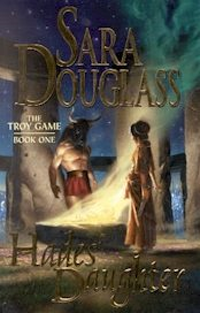Steven H. Silver wrote on SF Site:
From the very first pages of Sara Douglass's Hades' Daughter, it is clear that Douglass has a tightly packed and plotted series in mind. Epic in proportion, she is tackling nothing less than the course of Western civilization, from the fall of Troy until the Second World War, all set against a rotating cast of eternal heroes and villains and the Byzantine game they play – The Troy Game...Douglass draws her background from Greek mythology, the Iliad and Aeneid, as well as Geoffrey of Monmouth's account in Historia Regum Britanniae of the founding of Britain by Brutus, a descendent of Aeneas. She weaves these disparate mythical backgrounds together well, along with conjecture on the pre-Brutus beliefs indigenous to the British Isles...One of the strengths of Hades' Daughter is Douglass's decision not to present any of her characters as heroes or villains of the piece...Douglass's greatest strength is her ability to create interesting, believable, and well-researched worlds. Her characters are strong and flawed in a way to maintain the reader's interest. Her prose is, at times, plodding, but not to the extent that it stands in the way of either enjoying the story or reading through the hefty length of her works." [3]
